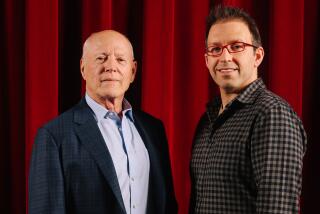Divine Lessons in Study of Miracles : Book Is Source of Inspiration to Followers, Who Meet in Groups to Learn Ways to Attain Spiritual Enlightenment
- Share via
FULLERTON — In their quest for enlightenment, Southern Californians have tried est, hung out with swamis, turned themselves into yoga pretzels and eaten psychedelic mushrooms.
The latest wave of soul-searchers are turning for inspiration to a big, blue gilt-embossed book titled “A Course in Miracles”--a half a million words of spiritual instruction, a how-to manifesto for changing the world by changing the mind.
Since it was first printed in the mid-1970s, the book has steadily grown into a grass-roots bestseller that has sold 800,000 copies at up to $40.
Its pupils have propagated at least 1,900 autonomous study groups worldwide that meet weekly in churches, homes, offices and bookstores. Although most are informal, some resemble church services, complete with collection baskets and music.
The single largest and most visible contingency of followers is in Southern California, where 200 study groups from Paso Robles to Chula Vista gather each week. One of the oldest is at the Fullerton-based Miracle Distribution Center.
In addition to sponsoring speakers, offering counseling and holding Easter and Christmas Eve services, the 6,000-square-foot center is the largest connection for course information worldwide. Among the services it provides is a bimonthly “Holy Encounter” newsletter, a recorded daily lesson on the 24-hour phone line.
Through its “Miracles by Mail” catalogue, customers can order the course plus more than 100 offshoot items including software, the board game “Love Is Letting Go of Fear” and buttons that say: “I don’t believe in miracles, I rely on them.”
While the course has followers in a number of countries--including India, Israel and Zimbabwe--most of those who have embraced it live in the United States. They reflect a spiritual smorgasbord of Christians, Jews, New Agers, 12-steppers, est graduates, burned-out yuppies and intellectuals.
Some “students” tout the tome as a correction and clarification of what Jesus really said 2,000 years ago. Others take a more tempered view, bypassing the issue of authorship and calling it a blend of contemporary psychological principles with those of Christian and Eastern philosophies.
Serious adherents study quietly alone every day, using 365 thought-training workbook exercises starting with, “Nothing I see . . . means anything.”
Thousands of proponents who have never cracked the original book devour dozens of related books and hundreds of tapes begot by high-profile course followers. In addition to newsletters and magazines, there are lectures, retreats and weekly conferences around the nation, with the highest concentrations of activity found on both coasts.
Like Alcoholics Anonymous, a self-help program grounded on the principle of anonymity, the course is supposed to have no official spokespeople, churches, proselytizing or membership dues.
The intent of the course, devotees say, is to be a disciplined self-study program. And because most followers study alone, it is difficult to estimate the number of serious adherents beyond book sales. But because of human nature’s tendency toward organization, autonomous study groups and centers have developed.
In Southern California, audiences have for a decade flocked to hear course woman-of-the-hour Marianne Williamson. She is author of the 1992 book “A Return to Love: Reflections on the Principles of a Course in Miracles.” Her racy, celebrity-attended lectures and appearance last year on Oprah Winfrey’s talk show helped spark a flurry of mainstream interest.
“I have never been as moved by a book,” Winfrey told viewers, adding that she had experienced 157 miracles since reading “Return to Love” and had purchased 1,000 copies for the studio audience.
In less public settings in Orange County and elsewhere, study groups meet to discuss what it all means.
At an evening session at the center in Fullerton, Beverly Hutchinson, the center’s president, invites group participants to share miracles that they have experienced during the past week.
One woman says she had been in physical pain when touring Catalina, but after repeating an affirmation beginning with “I am not my body,” her discomfort disappeared. “I was completely relaxed,” she says. “I was running up the stairs.”
Another, however, says she has not been seeing miracles. She says she met a man whose legs had been cut off by the Viet Cong. “I didn’t feel any miracle in that,” she says. “It affected me so badly that I’m not at peace.”
Hutchinson listens to each story and dispenses smiles and sympathy with a heavy peppering of course principles. Before ending with meditation and music, Hutchinson reminds the group that the course requires great effort.
“This is a course in mind training, not mind washing,” she says. “You can’t sit back in the celestial easy chair.”
*
It started about three decades ago in New York City. As the story goes, Helen Schucman--then 56 and an assistant professor of medical psychology at Columbia University Medical School--had for months been having unusual dreams and visions that culminated in an inner voice saying, “This is a course in miracles, please take notes.”
Disturbed by it, she confided in university colleague Bill Thetford, an agnostic who nevertheless encouraged her to listen to the voice that she said later identified itself as Jesus Christ.
Thus began seven years of collaborative scribing, with the reluctant Schucman dictating her shorthand notes and Thetford typing them.
Fearful of sullying their reputations, both were secretive about the finished product. One of the few people they showed it to was Judith Skutch (now Judith Skutch Whitson), who founded the Foundation for Parasensory Investigation in New York and taught experimental parapsychology at New York University. She supervised the first publication of the course--5,000 copies. The project was financed by an American industrialist living in Mexico.
Schucman, who remained ambivalent about practicing the course, died in 1981; Thetford, who devoted the rest of his life to studying it, died seven years later. Neither saw any financial gain from the course.
Some spinoff books, such as Gerald Jampolsky’s “Love Is Letting Go of Fear,” have sold far more copies than the course itself.
“A Course in Miracles” is still being printed by the same nonprofit publishing company, Foundation for Inner Peace, located north of San Francisco. Whitson, 62, is president of the publishing company and is overseeing the book’s translations into other languages.
“As far as the foundation goes,” she says, “it was always very clear that this was to be an unabridged, nonprofit, dignified and and low-key dissemination to other people seeking this particular form of an inner path.”
*
The Jesus of “A Course in Miracles” redefines sin and many other Christian terms, including Holy Spirit, God and atonement.
While the book has no simple Ten Commandments, it teaches that all problems come from choosing an illusory world view based on fear and separation from each other.
Critics range from fundamentalists who brand it as heresy to religion observers who call it a rehash of New Thought, an 1880s metaphysical movement that gave birth to religions such as Christian Science and Unity and paved the road to New Age beliefs in psychic phenomena and reincarnation.
Ford Greene, a Marin County attorney who specializes in anti-cult and psychological-injury litigation, says he has not heard of “any lawsuits filed or settlements involving ‘A Course in Miracles.’ ” And “it’s right here in my back yard.”
The course “is well-written, poetically beautiful and systematic,” says James R. Lewis, senior research associate at the Santa Barbara-based Institute for the Study of American Religion. “But it doesn’t really radically depart from the New Age thinking that we create our own reality.”
Roger Walsh, professor of psychiatry, philosophy and anthropology at UC Irvine, is an ardent proponent of the course and has written extensively about it.
He says the course’s popularity stems from a pent-up spiritual starvation not satisfied by dominant religions that today focus more on ritual than “personal experience of the divine.”
Grimacing at the term “New Age,” Walsh says the course is neither that nor the “typical guru-of-the-month seen so often in California.” He says it is a “spiritual masterpiece” that religion experts and other academics are today examining.
“There’s nothing that can’t be misused,” he says. “That’s the nature of human beings. But my take is that the course is exceedingly benign. It’s designed to produce love and compassion for self and others and warns against self-aggrandizement.”
Regarding its actual source, Walsh says people interpret that in many different ways. He himself does not believe the voice was literally that of Jesus.
“But that’s like worrying about the number of angels dancing on a pinhead,” he says. “The much more important question is does it work? Is it useful? Does it make people more compassionate, more kind?”
The answer, Walsh says, is yes.
“The key thing is that although it’s very sophisticated, it’s downright practical,” he says. “It’s a spiritual psychotherapy that many people are finding very useful in their lives.”
*
It’s Wednesday a shade after dusk at the Miracle Distribution Center, a buff-colored industrial building tucked between railroad tracks on a Fullerton side street.
Inside the dark-paneled room, about 30 people--an engineer, a third-year medical student, a retired stewardess, a school bus driver--sit on upholstered metal chairs. Copies of “A Course in Miracles” rest in their laps or on the floor by their feet.
Eyes shut, they listen as facilitator Beverly Hutchinson reads from an identical book, open on a lectern. “I am sustained by the love of God,” she says. The listeners repeat her words in unison, three times.
Completing the opening meditation, she stands and tells the assembly that the point of that night’s lesson is to remind them that depending on jobs, people, chocolate or Nordstrom charge cards will not bring them peace.
“If you do that, how much control do you have?” she asks. “Sometimes they’re there, sometimes not. You have it, you don’t have it. So you’re on a roller coaster.”
One man is not so sure about all this. The group is used to his ambivalence. They have previously dubbed him “Doubting Warren.”
“I loved chaos,” he says. “I’d rather go back to it sometimes because I get bored in serenity.”
Hutchinson laughs. “If you value the weekend of chaos, keep it,” she says. “But when you’re ready to choose again to feel God’s peace, you can and God will be there to support you.”
Later, Hutchinson sits in her small office. The former actress and agent says that although she has for years lectured internationally, she is not a “brand-name” course speaker.
Instead, she concentrates on running the networking center she co-founded with her brother in 1978, an organization that grew from a four-person study group they started in a Unity Church kitchen.
She says that at that time, the only other study group in the area was in Los Angeles, and the course was available only by mail from New York. They started ordering cases and the center evolved.
She laughs at her organization’s name. “People dial here by mistake,” she says. “We answer ‘Miracle Distribution Center’ and they say, ‘Oh yeah, distribute me one of those.’ ”
Other callers asking for miracles are serious.
“They’re laughing on the phone, but the subtext is that they really want a changed life,” she says. “They’re usually people who are at the bottom--a loved one has died, they have financial problems, a relationship has broken up. They’re scared and they’re down on their knees.”
That’s welcome news to Hutchinson, because the course requires great commitment, she says.
“It’s not roses and lollipops,” Hutchinson says. “It’s just the beginning of an internal housecleaning that will challenge all of their beliefs and give them the opportunity to heal very rapidly.”


